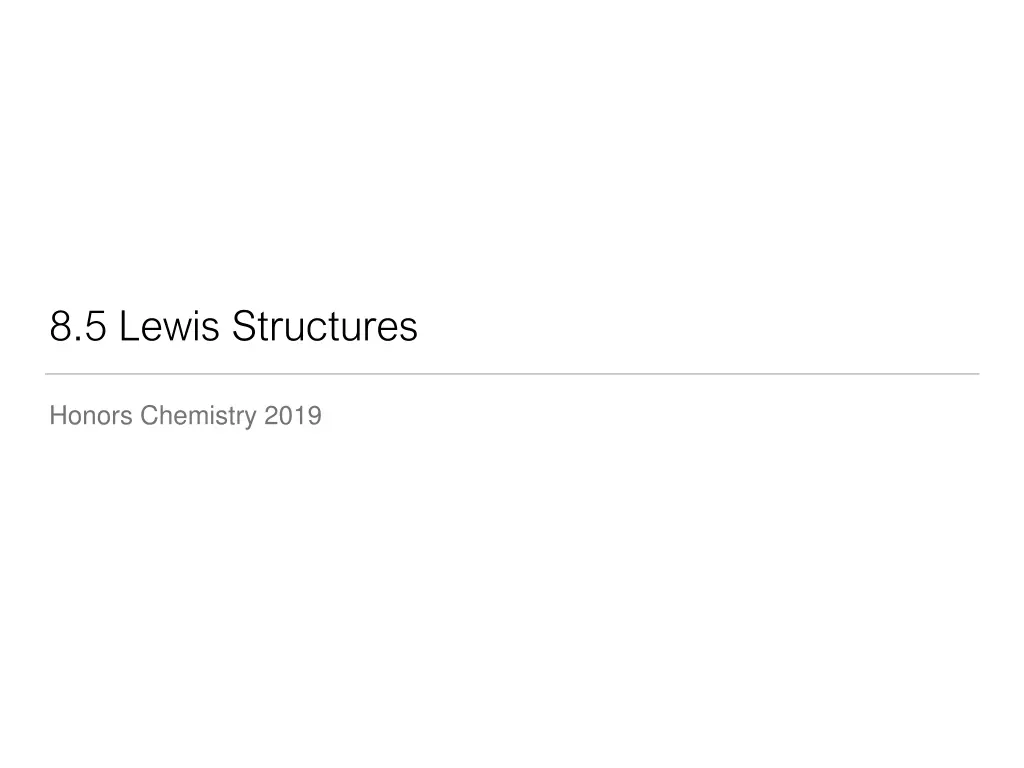
Lewis Structures: Drawing, Steps, Practice, and Formal Charges
Learn how to draw Lewis structures, the steps involved, practice with molecule examples, and understand formal charges in chemistry. Explore concepts like bonding properties, polarity, and more.
Download Presentation

Please find below an Image/Link to download the presentation.
The content on the website is provided AS IS for your information and personal use only. It may not be sold, licensed, or shared on other websites without obtaining consent from the author. If you encounter any issues during the download, it is possible that the publisher has removed the file from their server.
You are allowed to download the files provided on this website for personal or commercial use, subject to the condition that they are used lawfully. All files are the property of their respective owners.
The content on the website is provided AS IS for your information and personal use only. It may not be sold, licensed, or shared on other websites without obtaining consent from the author.
E N D
Presentation Transcript
8.5 Lewis Structures Honors Chemistry 2019
8.5 Drawing Lewis Structures We have already practiced this a bit Let s take a deeper look into the strategies and concepts behind lewis structures Remember that this concept has wide applications Bonding properties Bond angles Polarity etc. We should be really confident about our abilities to draw lewis structures after this unit, as it comes up quite a lot
8.5 Steps in Drawing Lewis Structures First of all, it takes practice (+ is the absence of an electron, - is one additional electron in the structure) Steps 1. Sum the valence electrons from all atoms For anions add one, for cations subtract one 2. Write symbols for the elements and draw a line for a single bond When a central atom has a group of atoms bound to it, it is typically written first SiF4 Molecules are often written in the order in which they are bonded i.e. HCN
8.5 Steps in Drawing Lewis Structures Steps Continued 3.) Complete the octets around all the atoms bonded to the central atom Hydrogen is the exception 4.) Place any leftover electrons on the central atom Even if this results in extra around the central (we ll get to this later 5.) If there are not enough electrons to give the central atom an octet, try multiple bonds Use some of the unshared pairs to make a double or triple bond
8.5 Lewis Structure Practice Using the steps practice drawing the following PCl3 HBr Cl2 CCl4 NO+ C2H2
8.5 Formal Charges In some situations it is possible to draw more than one correct lewis structure Formal charges - the charge on an atom in molecule if all atoms in the molecule had the same electronegavity For lone electrons, they are assigned to the atom to which they are attached (one negative) For bonds, the electrons are halved and charges are distributed to each element (1/2 the number of electrons in the bond)
8.5 Calculating formal charges To calculate formal charges . you subtract the number of electrons assigned to the element from the number of valence electrons typically on that element
8.5 Example CO2: 1.) # of valence electrons typically on a each element 2.) # of electrons assigned to the element in the bond Subtract Valence - Assigned = Formal Charge
Practice Determine the formal charge from each arrangement and decide which structure is correct
8.5 Rules for formal charges Rule #1: We generally choose the lewis structure in which the atoms bear formal charges closest to zero Explains CO2 We generally choose the lewis structure in which negative charges reside on the more electronegative elements Explains HCN
8.5 Practice Draw the Lewis structures for each of the following and write oxidation numbers and formal charges on all atoms. SO2 SO3 SO32-
